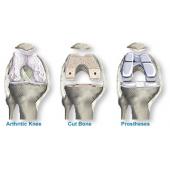Total Knee Replacement
The illustration at the right shows the knee during several stages of knee replacement.
Arthritis of the knees can be mechanical (osteoarthritis), in which the surfaces of the knee gradually wear out. This may be due to either old age, angular deformity, or old fractures. Systemic arthritis, such as rheumatoid arthritis or gout, affects the synovium (the membrane tissue in the joint that normally lubricates the joint) and becomes pathologic, and the surface of the joint is destroyed.
In either case, when the surface of the joint is worn away, walking and activities of daily living become very difficult. Standardized treatment, such as weight loss, anti-inflammatory medication, braces, orthotics, steroid injections, and physical therapy, are all tried and are often successful.
In many cases, however, functional limitations persist despite conservative treatment attempts. Most people who are considering knee replacement are limited to walking less than three to six blocks or for less than 15 to 20 minutes. They have difficult time getting up out of a chair. They have rest pain. They are taking anti-inflammatory medication and/or pain medicine on a regular basis, and the pain is generally progressive.
It is important to realize that a knee replacement is actually just a "resurfacing" of the knee joint. The femur or thigh bone is covered with a metal covering and plastic is placed on the tibia so that, instead of irregular arthritic surfaces, one has metal and plastic articulating, which produces a smooth, non-patent surface. In most cases, the undersurface of the kneecap is also replaced with a plastic surface so that this articulates with the femoral surface.
Knee replacements have been done since the early 1970s, and our most recent designs appear to have 85% to 90% survival after 20 years.
The actual procedure involving knee replacement involves either general or epidural anesthesia with a four to six day hospitalization. The surgery itself takes between 1.5 and 2.5 hours. In most cases, patients donate two units of autologous blood to be used in the post-operative period. Weight-bearing begins immediately the first post-operative day. Patients usually use a walker for a period of one to two weeks, going to crutches, and then a cane. Patients are off all ambulatory assistive devices anywhere from three weeks and two months.
Success rates in knee replacements are approximately 90%. This can be due to either stiffness or ache or swelling in the knee. The most significant complications, aside from general medical complications (heart and lung) involve infection of the prosthesis. If this occurs, in some cases, the prosthesis can be saved and the patient taken back to the operating room, the knee irrigated with antibiotic irrigation, and then begin antibiotics. In some cases, if this does not respond, the entire prosthesis must be taken out and antibodies given for six weeks before an attempt at re-implantation of the of the prosthesis can occur. In an extremely small percentage of cases, conceivably if the infection could not be controlled, then one is left with the option of undergoing a knee fusion in which the femur and tibia are fused in one bone.
Activities after knee replacement that should produce no difficulty are simple walking, bicycling, golfing, swimming. The prosthesis is not designed for impact-loading sports, such as skiing, basketball, racquetball, etc.


